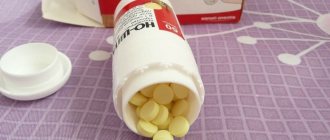Constipation for infants is by no means uncommon, but there is no need to rush to use outdated methods, such as an enema or a bar of soap, as in ancient times, to solve the problem. You should help your baby using proven medications sold in pharmacies. Most often, the choice is made of suppositories or microenemas. The main disadvantage of glycerin suppositories is the lack of children's dosages, therefore it is strongly recommended to choose microenemas. Microlax for newborns is an excellent remedy that will help even the little ones quickly and gently cope with a delicate problem.
Many parents appreciated Microlax
The drug has been actively prescribed by pediatricians to the youngest children for a number of years, and no particular problems have arisen with its use. However, before taking Microlax for infants into service in the fight against diarrhea, it is strongly recommended to obtain as much detailed information as possible about it.
What is Microlax
Microlax for babies is a kind of enema in a plastic tube with a volume of 5 ml. Depending on the layout, the box with the medicine contains 4 or 12 tubes. Microlax is produced in the format of a colorless viscous solution intended for administration into the rectum.

Almost every baby experiences constipation from time to time.
Microlax
Microlax is a multicomponent medicine with a laxative effect from FAMAR ORLEANS (France). The manufacturer put it in the form of a solution intended for rectal administration in the form of microenemas. The solution itself is placed in polyvinyl chloride tubes equipped with a tapered tip. A break-off seal is designed to control tampering. Pharmacological properties are determined by the active ingredients and formative substances included in the drug. Sodium citrate (sodium salt of citric acid) is a peptizer, i.e. capable of breaking down substances into primary particles in a liquid environment. It pushes out the fluid that has accumulated in the feces and is in a bound state. The anionic surfactant sodium lauryl sulfoacetate makes the digested food bolus in the intestines more liquid and homogeneous. Sorbitol potentiates the laxative effect by attracting fluid into the digestive tract. Intestinal hydration provided by these two processes - peptization and liquefaction - softens stool and promotes more efficient and productive bowel movements. The speed of onset of the laxative effect ranges from 5 to 15 minutes from the moment of administration, depending on the degree of intestinal filling. Microlaxa. The drug is indicated for constipation, including those accompanied by an inability to control the act of defecation, and also as an aid in preparation for diagnostic instrumental (x-ray and endoscopy) studies of the digestive tract. The introduction of Microlax has its own age-related characteristics.
Thus, for adult patients and children over three years of age, the tube is inserted into the anus along the entire length of the tip, and for newborns and children under 3 years old - half its length, until a special mark is applied to the tip. 1 microenema is administered at a time. Before administration you must:
• remove the seal on the tip;
• squeeze out one drop to lubricate the tip to facilitate its sliding in the rectum;
• insert the tip of the tube into the anus;
• completely squeeze the solution into the rectum;
• remove the tube from the anus, keeping it slightly compressed.
Side effects when using Microlax are observed very rarely (less than 0.01% of cases). This is pain in the abdomen, discomfort in the anorectal area, liquid stool, hypersensitivity reactions. No studies have been conducted on the use of Microlax in pregnant and lactating women. Considering that the drug is practically not absorbed into the systemic circulation, it, apparently, will have absolutely no negative effects on the fetus, the infant, or the woman herself. If the drug is ineffective for a long time, you should consult a doctor for a more detailed diagnosis and adjustment of treatment. Cases of Microlax overdose have not been described in the medical literature. When used together with sodium polystyrene sulfonate, necrosis of the large intestine is possible due to interaction with the sorbitol contained in the drug.
Operating principle
Vaseline oil and ointment for newborns
Microlax for newborns has a very simple principle of action. The components included in its composition allow you to quickly and effectively soften stool and thereby facilitate the process of defecation. The laxative effect occurs 5-10 minutes after using the product (rarely within 20-30 minutes).
Since Microlax, intended for infants, is intended to be administered rectally, its components do not penetrate into the body. In other words, the effect of the Microlax enema for newborns is limited to the local level, which ensures its complete safety when used in the treatment of constipation in babies.

If you choose the right medicine, you can quickly relieve constipation
Treatment of constipation in a nursing mother
Treatment of constipation in a nursing mother should be comprehensive, so close attention should be paid to changing the woman’s lifestyle and diet. General recommendations include moving and exercising more, including a significant amount of fresh vegetables and fruits in the menu, and eating less protein and fatty foods. In this case, there is a high probability that constipation in both the nursing mother and the baby will go away faster. In the first half of the year, such ailments in a child may be associated with food allergies, so it is better to remove milk, fish and nuts from the diet. In addition, the following products should be excluded:
- containing tannin (natural coffee, strong black and green tea, pomegranate juice, winter pears, quince);
- reducing the functioning of the colon (rice, jelly, cocoa);
- causing intestinal irritation (radish, onion, radish, garlic);
- increasing gas formation (cabbage, beans, peas, brown bread);
- containing large amounts of animal fats;
- promoting constipation (baked goods, white bread, pasta, crackers).
The diet of a nursing woman should include:
- fermented milk products (yogurt, natural kefir);
- foods high in fiber (vegetables, fruits, cereals, wholemeal bread);
- liquid soups;
- lean meat;
- vegetable oils.
If constipated, a nursing mother should follow a drinking regime. You can consume water, tea, compotes, rosehip decoction, diluted juices, chicory. Both mother and child need to spend more time outdoors. And, of course, you should avoid stress if possible and be less nervous. Thus, treating constipation in a nursing mother and baby will bring positive results faster.
Up to contents
What is it used for?
In accordance with the instructions for use of children's Microlax for infants, the drug is prescribed to eliminate constipation of various etiologies.
Symptoms of teething in infants
Even if the child has not yet crossed the one-month mark of life, it is quite acceptable to use the drug. Parents often resort to its use when the baby is unable to empty his intestines when switching to artificial nutrition, if the child has colic, or various digestive problems arise. Mothers who are breastfeeding their babies can also use Microlax without thinking that it is harmful.
Important! When giving Microlax to a baby, you should understand that the drug does not eliminate the cause of constipation. Therefore, it is recommended to use it exclusively as an emergency drug.
Under normal conditions, infants should have bowel movements 2-3 times a day. In this case, the feces should be mushy and soft. If a child does not walk “in a big way” for more than a day, he may experience increased gas formation and bloating - all this indicates the presence of constipation. In most cases, the stool becomes hard and dry. It is in this situation that Microlax turns out to be especially highly effective.
Important! Without a pediatrician's prescription, a baby can be given a microenema only if he does not have any alarming symptoms: pain, fever, bloating, and the child behaves as usual.
Causes of constipation during breastfeeding (lactation)
For a nursing mother
The main cause of constipation during breastfeeding is the same as during pregnancy: due to an enlarged uterus, the pelvic organs (and especially the intestines) are displaced, which affects their function. After childbirth, the normal position is restored, but not immediately. In addition, during this period the hormone progesterone continues to be produced, which has a relaxing effect on the intestines. This contributes to the deterioration of its peristalsis (contraction), which can cause constipation in a nursing mother. In addition to these reasons, the following predispose to the occurrence of malaise:
- lack of physical activity;
- lack of dietary fiber in the diet (many nursing women deny themselves vegetables and fruits);
- hemorrhoidal nodules that appear after childbirth, which cause discomfort during bowel movements and inhibition of urges;
- the presence of various diseases (inflammatory processes, metabolic disorders, endocrine disorders, etc.);
- taking certain medications (for example, iron supplements).
At the baby's
Constipation in breastfed children is most often provoked by the following factors:
- improper nutrition of a nursing mother (excess in the diet of baked goods, meat, rice, black tea, coffee, nuts and other foods with a fixing effect);
- sudden changes in the child’s diet (stool disorders can be caused by a rapid transition from breast milk to artificial formula or the early introduction of complementary foods - solid foods up to 6 months);
- lack of fluid (lack of breast milk can cause so-called “hunger constipation”, and water – deterioration of peristalsis and hardening of stool).
Is the drug harmful to the baby?
In general, microenemas for newborns are considered safe. Before an infant who is barely a month old tries it on himself, parents should make sure that he does not have an allergic reaction to the components of the drug.
Important! An allergic reaction in a newborn is extremely dangerous. Even death is possible.
Experts do not recommend using Microlax on an ongoing basis or for a long time. Overdose, addiction, or even “lazy bowel syndrome” may occur. The latter refers to a situation in which the body stops independently producing bowel movements. This only happens with additional stimulation with the drug.

Drugs like Microlax should not be abused in infants.
It is equally important when using the drug to strictly adhere to the dosage. If it is exceeded, the following unpleasant symptoms may appear in the baby:
- burning in the rectal area;
- disruption of the digestive process;
- colic;
- loose stool.
Instructions for use
Whatever laxative drug we are talking about, be it a suppository or a product like Microlax, it is very important to do everything correctly. Therefore, for most parents, the question of how to properly administer Microlax to a baby is very relevant.
Before giving Microlax to a baby, you should understand the dosage. One tube of the drug corresponds to a single dose for a newborn baby. The product should be used following the following simple procedure:
- Wash your hands thoroughly.
- Wash the child’s skin in the anus area no less thoroughly.
- Place the baby on a flat, clean surface on its back.
- Raise the baby's legs a little.
- Carefully break off the tip from the tube of medication.
- Lubricate the tip with Vaseline.
- Press lightly on the tube until the product appears.
- Insert into the anus (the tip must be inserted into the anus up to the half indicated by the mark).
- Squeeze out the entire contents of the tube.
- Without unclenching your fingertips, remove the tip from the anus.
- Squeeze the baby's buttocks for several minutes.
Many parents refuse to use Microlax because it is sold as enemas. But it is this format, which involves direct administration of the drug, that provides almost instantaneous action.

When using Microlax it is very important to follow the dosage
Important! If the drug does not have any effect within half an hour, you can try giving the baby a little water and transfer it to his tummy.
How often can I use it?
When using Microlax, it is important to know how much of the drug can be given to a newborn baby and how often. Symptoms of overdose may appear when more than 1 dose of the drug is used during the day.
Under no circumstances should Microlax be used in conjunction with medications containing sodium polystyrene sulfonate. When it interacts with sorbitol, intestinal necrosis may develop. It is for this reason that before solving even the most minor problems associated with bowel movements in newborns, it is strongly recommended to consult a doctor.

It is often impossible to determine the presence of digestive problems by the baby’s appearance.
Microlax is valued for its fast action and high efficiency. You can buy it without a prescription at almost any pharmacy. The drug comes to the domestic market from two main manufacturers: the French pharmaceutical company Faman Orleans and the world-famous American corporation Johnson & Johnson. Both manufacturers guarantee the quality of their product, so you can buy it without any worries. The most important thing is to make a purchase at a trusted pharmacy that does not display counterfeit medicines on display.











